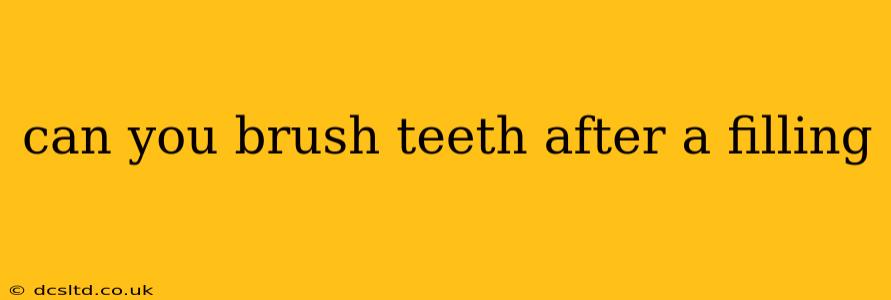Getting a dental filling is a common procedure, and afterward, you're likely wondering about your oral hygiene routine. The short answer is yes, you can brush your teeth after a filling, but with some important caveats. The immediate post-filling period requires a gentle approach to protect the newly placed filling and the surrounding tooth.
How Soon After a Filling Can I Brush My Teeth?
Ideally, you should wait at least two hours after getting a filling before brushing your teeth. This allows the anesthetic to wear off completely and the filling material to begin setting properly. Brushing too soon could dislodge the filling, especially if it's a temporary filling. Your dentist will provide specific instructions, so always follow their advice.
What Kind of Toothbrush Should I Use After a Filling?
Use a soft-bristled toothbrush for at least the first few days after your filling. A soft brush is gentler on the sensitive area around the filling and reduces the risk of irritation or damage. Avoid using hard-bristled brushes, electric toothbrushes with vigorous settings, or abrasive whitening toothpastes during this time.
How Should I Brush My Teeth After a Filling?
Gentle, circular motions are best. Focus on cleaning the area around the filling carefully but avoid putting excessive pressure on the newly placed filling. It's crucial to clean the area thoroughly to prevent food particles from getting trapped and causing irritation or infection.
What if My Teeth Still Feel Sensitive After a Filling?
Some sensitivity is normal in the days following a filling. However, if the sensitivity persists or worsens, contact your dentist immediately. They can assess the situation and rule out any complications.
Can I Use Mouthwash After a Filling?
Yes, you can use mouthwash, but choose an alcohol-free variety, especially in the immediate aftermath of the procedure. Alcohol can irritate the sensitive area around the filling. Rinse gently to avoid dislodging the filling.
What About Flossing After a Filling?
Flossing is also important, but be gentle around the filled tooth. You may want to avoid flossing directly on the filling for the first day or two, focusing on the surrounding teeth. Again, your dentist's specific recommendations should be followed.
What are the Signs of a Problem with My New Filling?
While minor sensitivity is common, contact your dentist if you experience:
- Severe or persistent pain: This could indicate a problem with the filling or an underlying issue.
- The filling feeling loose or falling out: This requires immediate attention.
- Persistent bleeding or swelling: These are signs of infection or irritation.
- A change in the bite: If your bite feels different after the filling, it's crucial to consult your dentist.
Following your dentist's post-operative instructions and practicing gentle oral hygiene is vital for the long-term success of your dental filling. By taking care, you can help ensure your filling lasts for many years to come. Remember, your dentist is your best resource for personalized advice and care. If you have any concerns, don't hesitate to contact them.
